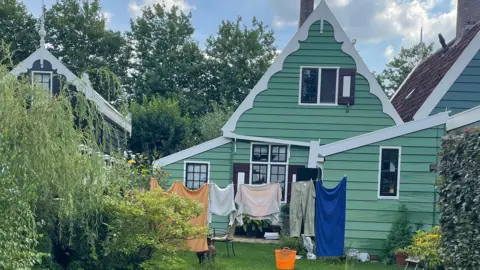Business
Zaanse Schans: The picturesque Dutch village set to charge tourists an entry fee

John LaurensonBusiness reporter, Zaanse Schans, Netherlands
 Getty Images
Getty ImagesThe historic Dutch village of Zaanse Schans is well known for its windmills, which a heck of a lot of tourists want to go to see.
Indeed, they are some of the most picturesque examples in the Netherlands, and easy to get to from Amsterdam.
Last year, 2.6 million people visited – a gigantic amount for a small place with a resident population of just 100.
It is far too many tourists, says the local council. And so, it has announced that from next spring it will charge every visitor from outside the area €17.50 ($20.50; £15) to enter, to try to control the numbers.
It’s very rare for a community to take such a measure, but talking to Marieke Verweij, director of the village’s museum, you can understand why they want to do this.
“In 2017 we had 1.7 million visitors… this year we’re heading for 2.8 million,” she says. “But this is a small place! We just don’t have room for all these people!”
Worse, says Marieke Verweij, visitors often “don’t know that people live here so they walk into their gardens, they walk into their houses, they pee into their gardens, they knock on doors, they take pictures, they use selfie sticks to peek into the houses. So no privacy at all.”
I leave the museum and walk past a coach car park in the general direction of the windmills. I probably shouldn’t say this, as it’s just going to make the problem worse, but these are some fabulous windmills.
One of them is wooden and painted green. Another has thatched walls.
Every so often the wind picks up and their sails go round. It’s a fine sight – and one most people would want to get a picture with.
A lot of people are doing just that, of course. The windmills are actually still quite a long way off but, at the best spots, visitors form very civilised selfie-queues.
There’s a bit of a queue also at a little bridge that leads over a canal towards the windmills. As I edge forward I hear Chinese, English, Spanish, Arabic, Italian and Russian.
The plan is to get everyone to book and pay online. The sort of thing you often have to do now to visit museums post-Covid.
The sweetener for tourists is that for the €17.50 they get admission to two things they currently have to pay for separately anyway – entry to the museum and to the inside of the windmills.
The former contains a painting of the local windmills by French impressionist Claude Monet, who visited in 1871. In the latter you can see how, in the 17th Century, the Dutch were using windmills not just to grind grain, but to do things like grind pigments to make paint or saw wood.

If only half the current numbers keep visiting after the admission charge is introduced, annual revenues will be around €24.5m.
The council plans to spend the money on maintenance of the windmills and on new infrastructure. New toilets, for example. But the shop and restaurant owners are not happy at all.
The stores, it should be said, are a bit of an attraction in themselves. The staff wear traditional costumes in the cheese shop, they do clog-making demonstrations in the shoe store.
And they are located inside old and beautiful wooden houses. The antique and gift shop for example, dates from 1623.
The planned entrance charge is threatening the livelihoods of Zaanse Schans’s retailers and restaurant-owners, says Sterre Schaap. She co-runs the gift shop, which is called Trash and Treasures.
“It’s awful. It will mean that people who don’t have a big wallet won’t be able to come here,” says Ms Schaap. “It will mean that we will lose a lot of our shoppers.
“If you’re with a family of four and you have parking, it will be around €100. So people won’t have a lot of budget over for other stuff.”

I wander up to the windmills, past a young woman who’s photographing her friend, and a couple from Germany who are taking a selfie.
Up on the balcony of one of the windmills, looking out at the impressive flatness of Holland, I get talking to Ishan from Canada. “I don’t know if I’d pay the €17.50 to come here. It’s a bit steep just to see a couple of windmills,” he says.
But Elisia, who is Albanian, grew up in Greece, and now lives in the Netherlands, says she would definitely pay that amount. “These villages, they are not so big and they lose their charm when there are so many tourists,” she says.
Steve, who’s over with his family from Massachusetts in the US, has been doing his calculations and can see the good side of the upcoming charge.
“Cheap people like me,” says Steve, “look at the windmill and say ‘nah, I’m not gonna pay extra to go in there’, but if it’s all included I wouldn’t hesitate.”
It’d be a more complete experience, he says, and not a bad deal.
 John Laurenson
John LaurensonThe deal is also a sign of the times. Rachel Dodds, a professor of tourism at Canada’s Toronto Metropolitan University, points out a few comparable cases.
“Bhutan charges an entry fee per day to visit the country. Venice, of course, is probably the most famous one with €5 for day trippers,” she says.
Meanwhile, the US and the UK both charge travel authorisation or visa fees for foreign nationals to visit them.
Yet villages that charge entrance fees are still very rare. Current other examples are the privately owned fishing village of Clovelly in Devon, England, the medieval Civita de Bagnoregio and Corenno Plinio in Italy, and Penglipuran in Bali, Indonesia.
As I wait for my bus to leave Zaanse Schans, a bus load of people arrive, swiping their credit cards to pay for their rides.
Those who arrive in a few months time will be digging around for pre-paid entry tickets, too.
Business
Gems trade slump: Exports fall 31% in October; bullion volatility, early US stocking hit demand – The Times of India

India’s gems and jewellery exports fell sharply in October, sliding 30.57% to $2.17 billion (Rs 19,172.89 crore) compared to the same month last year, according to data released by the Gems and Jewellery Export Promotion Council (GJEPC), PTI reported.Exports in October 2024 had stood at $3.12 billion (Rs 26,237.1 crore).GJEPC chairman Kirit Bhansali said the decline was largely expected, as overseas buyers had advanced their festive-season stocking before the US tariff came into effect.“Most of the stocking up for the festivals took place before August 27. Therefore, in October the demand was down. The decline in gold and silver exports is triggered by volatile bullion prices,” Bhansali told PTI.He added that exports should revive in November with Chinese market recovery and Christmas demand from major global buyers.Exports of cut and polished diamonds fell 26.97% to $1.02 billion (Rs 9,071.41 crore), down from $1.40 billion (Rs 11,806.45 crore) a year earlier.Shipments of polished lab-grown diamonds also saw a steep slide of 34.90% to $94.37 million (Rs 834.45 crore), compared with $144.96 million (Rs 1,218.25 crore) last October.Gold jewellery exports dropped 28.4% to $850.15 million (Rs 7,520.34 crore) from $1.18 billion (Rs 9,975.17 crore) a year earlier.Exports of coloured gemstones during April–October slipped 3.21% to $250.14 million (Rs 2,173.08 crore).Silver jewellery shipments dipped 16% in October to $121.37 million (Rs 1,072.81 crore), down from $145.05 million (Rs 1,219.01 crore) in 2024.
Business
DAMAC Properties Unveils Master Development, Launches New Sales Office In Egypt

Last Updated:
DAMAC launched DAMAC Islands 2 and a new Cairo office at the Grand Egyptian Museum, with Hussain Sajwani and Amira Sajwani hosting. Omar Khairat performed.

DAMAC (Representative Image)
DAMAC marked the launch of its new master development DAMAC Islands 2 and its new sales office opening in Egypt with a grand celebration in Egypt at the magnificent Grand Egyptian Museum, an architectural and cultural marvel overlooking the Pyramids of Giza. The glittering evening set against the backdrop of ancient history was hosted by Hussain Sajwani, Founder and Chairman of DAMAC Group, and Amira Sajwani, Managing Director of DAMAC Properties, who welcomed an audience of dignitaries, global investors, media, brokers, and VIP guests from across the world.
Guests at the event were given an exclusive preview of DAMAC Islands 2, the latest luxury community in Dubai, inspired by eight tropical island destinations. The project followed the phenomenal success of DAMAC Islands 1 in 2024, which achieved a record-breaking sell-out. DAMAC sold AED 10 billion in inventory, generating the highest revenue from a real estate launch in 24 hours, as recognised by the Guinness World Records.
The evening’s headline act was legendary Egyptian musician Omar Khairat, who regaled the audience with a captivating fusion of classical, jazz, and traditional Arabic music. Hadi Awada presented a thrilling, choreographed performance.
Hussain Sajwani, Founder of DAMAC Group, said: “This grand celebration and our presence in Cairo represents an affirmation of our deep connection with Egypt. This market has long been one of our most dynamic and promising markets. We’re here to bring DAMAC’s international portfolio closer to Egyptian investors who seek both quality and long-term value.”
Amira Sajwani, Managing Director of DAMAC Properties, noted: “Egyptians already rank among the top ten nationalities purchasing DAMAC homes. We have witnessed double-digit sales growth in this market and expect it to rise another 20% in 2026. Opening our Cairo office also brings us closer to our clients and strengthens the bridge between Cairo and Dubai, the two powerhouses of real estate investment in the MENA region.”
Dubai’s real estate market remains one of the world’s most active and attractive amongst investors and residents alike – with H1 2025 transactions up 40% year-on-year, reinforcing DAMAC’s position at the intersection of two of the region’s most vibrant markets. Furthermore, DAMAC communities continue to lead market performance, with DAMAC Islands recording 4,185 villa and townhouse sales in H1 2025 and DAMAC Hills 2 registering 1,942 sales.
On average from launch, price growth at DAMAC Hills 1 townhouses rose 86 per cent, DAMAC Hills 1 villas 72 per cent, DAMAC Hills 2 townhouses 60 per cent, and DAMAC Islands villas 29 per cent, demonstrating sustained investor confidence in the brand’s long-term value.
DAMAC Islands 2 brings the rhythm of the tropics to the heart of Dubai; blending lush landscapes, crystal lagoons, and wellness-driven design inspired by eight dream destinations: Antigua, Bahamas, Barbados, Bermuda, Cuba, Maui, Mauritius, and Tahiti. As part of the launch campaign for DAMAC Islands 2, DAMAC also launched a unique global competition to become ‘The Ultimate Islander’.
The competition winner will receive an all-expenses-paid trip and become an employee of DAMAC while living on one of their eight islands. The master-planned project will comprise six-bedroom luxury villas of approximately 583 square meters, five-bedroom twin villas of approximately 324 square meters, five-bedroom townhouses of approximately 293 and 263 square meters, and four-bedroom townhouses of approximately 203 square meters. Prices start at AED 2.7 million.
A team of writers and reporters decodes vast terms of personal finance and making money matters simpler for you. From latest initial public offerings (IPOs) in the market to best investment options, we cover al…Read More
A team of writers and reporters decodes vast terms of personal finance and making money matters simpler for you. From latest initial public offerings (IPOs) in the market to best investment options, we cover al… Read More
November 15, 2025, 13:25 IST
Read More
Business
Gold Loan Tips: 3 Repayment Tricks That Can Save You A Fortune

Last Updated:
Three repayment choices, one crucial decision — and the difference could cost you lakhs. Pick wisely, and a gold loan becomes far lighter on both your mind and your pocket
Selecting the right gold loan repayment method can save you money. (AI Generated)
Gold loans may be easy to take, but they are not always easy to repay, and a small mistake can cost borrowers thousands, even lakhs, in extra interest. Most people focus only on the 9-10 per cent interest rate, unaware that the real cost depends entirely on the repayment method they choose.
One wrong decision can make a cheap loan expensive; the right one can make it far more affordable.
According to an Economic Times report, Jijith Raj, Business Head at Indel Money, has explained three loan repayment methods and who each of them is best suited for.
1. Regular EMI
In this method, you pay a fixed instalment every month, which includes both principal and interest. As the months pass, the principal reduces, and the total interest you pay is the lowest among the three options.
This method is ideal for people who earn a regular monthly income like salaried employees, pensioners, or those receiving steady rental income. Setting up an auto-debit ensures discipline.
However, if you miss even a single EMI, the bank may quickly classify your account as an SMA and report it to the credit bureau, which can lower your CIBIL score.
2. Bullet Repayment
This is the option most people prefer because it gives them the highest level of flexibility. You may pay nothing or only the interest during the loan period, and then clear the entire principal and remaining interest in one go on the final day. This method works well if you are certain that you will receive a large sum within 6-12 months, such as from selling property, an FD maturing, or a sizeable business payment.
But the risk is high: if you are unable to arrange the lump sum by the due date, the interest balloons because the full principal remains unpaid.
Moreover, 45 days after the loan period ends, the bank can begin the process of auctioning your gold, which catches many borrowers off-guard.
3. Overdraft Facility
This option may appear slightly more expensive upfront, but it is perfect for those with irregular income like freelancers, small shop owners, agents who work on commission, consultants, and similar professions.
The bank sanctions a limit (for example, Rs 10 lakh), and you pay interest only on the amount you actually withdraw, not on the entire limit. When you receive money, you can deposit it back instantly, and your interest reduces immediately. You can withdraw and deposit as many times as you wish.
If you need a top-up, it is usually granted without closing the existing loan. Although the interest rate might be a bit higher, the overall cost remains low because your outstanding balance typically stays small.
Which Method Saves The Most?
- If your income is steady, choose EMI as it results in the lowest interest outflow.
- If you are expecting a lump sum, bullet repayment can work but it is risky.
- If your income is irregular, opt for the overdraft facility, which keeps your interest under control.
A crucial tip: If you have chosen the wrong repayment scheme earlier and a major portion of your loan tenure still remains, close the old loan and take a new loan against the same gold under a better scheme.
Most companies do not charge foreclosure fees, but always confirm this before proceeding.
November 15, 2025, 11:42 IST
Read More
-

 Entertainment1 week ago
Entertainment1 week agoChina unveils£5.4 bn Fujian, its most advanced aircraft carrier yet
-

 Politics1 week ago
Politics1 week agoIDF lawyers warned of possible Gaza war crimes: US intel findings
-

 Entertainment1 week ago
Entertainment1 week agoRobert Pattinson jokes about competing with Gen Z
-

 Business1 week ago
Business1 week agoBudget tax hikes could see food prices soar, major supermarket boss warns
-

 Tech1 week ago
Tech1 week agoThe Government Shutdown Is a Ticking Cybersecurity Time Bomb
-

 Sports1 week ago
Sports1 week agoIsraeli cycling team loses top sponsor despite honoring request to remove country from name
-
Sports6 days ago
College football winners and losers: The catch of the year saves Indiana
-

 Business6 days ago
Business6 days agoMore than 1,000 flights cancelled as US air traffic cuts enter second day







